Organisational Behavior Analysis: 1Spatial, PLC - Module Report
VerifiedAdded on 2020/12/10
|11
|3275
|454
Report
AI Summary
This report provides an in-depth analysis of organisational behavior within 1Spatial, PLC, a geospatial data leader. It examines the impact of culture, power, and politics on individual and team behavior, considering factors such as power dynamics and cultural differences using Hofstede's theory. The report further assesses the application of content and process theories of motivation, including McClelland's Need Theory and Maslow's Hierarchy, to enhance goal attainment within the company. It also explores motivational techniques and the influence of emotional intelligence and psychodynamic approaches. Finally, the report compares and contrasts effective and ineffective teams, using Tuckman's model to support the development of dynamic cooperation within 1Spatial, PLC, and discusses functional and problem-solving teams, to suggest practical strategies for improving employee performance and organisational effectiveness.
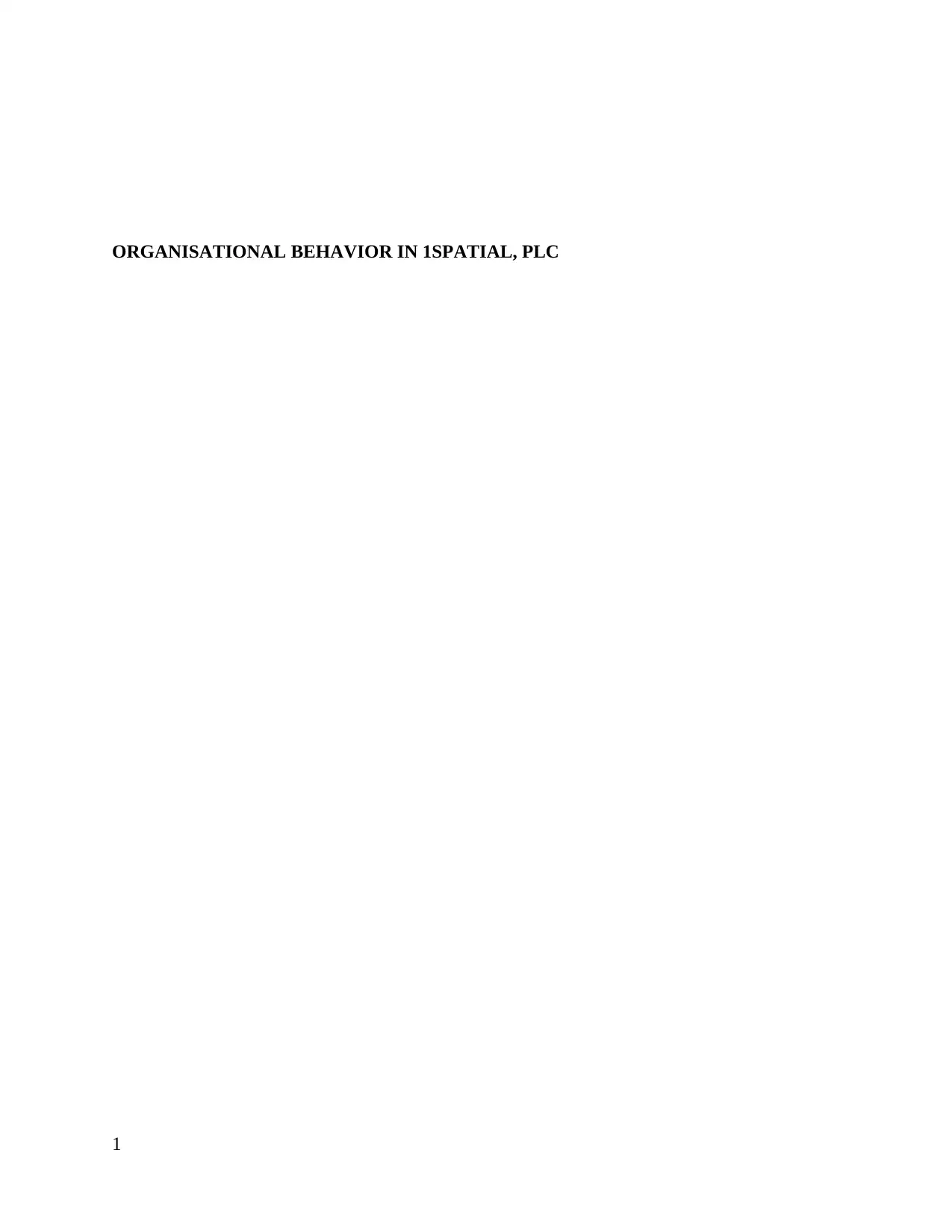
ORGANISATIONAL BEHAVIOR IN 1SPATIAL, PLC
1
1
Paraphrase This Document
Need a fresh take? Get an instant paraphrase of this document with our AI Paraphraser
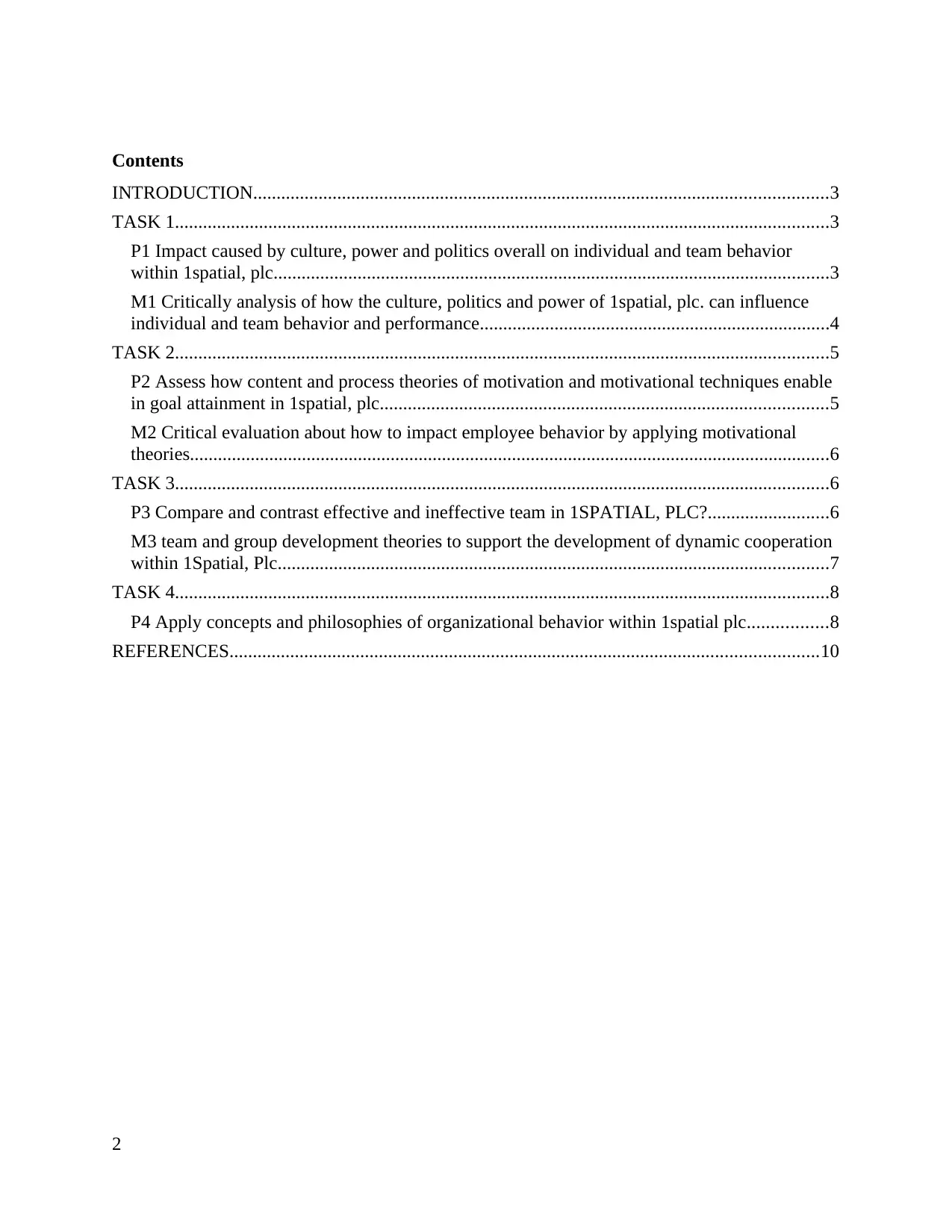
Contents
INTRODUCTION...........................................................................................................................3
TASK 1............................................................................................................................................3
P1 Impact caused by culture, power and politics overall on individual and team behavior
within 1spatial, plc.......................................................................................................................3
M1 Critically analysis of how the culture, politics and power of 1spatial, plc. can influence
individual and team behavior and performance...........................................................................4
TASK 2............................................................................................................................................5
P2 Assess how content and process theories of motivation and motivational techniques enable
in goal attainment in 1spatial, plc................................................................................................5
M2 Critical evaluation about how to impact employee behavior by applying motivational
theories.........................................................................................................................................6
TASK 3............................................................................................................................................6
P3 Compare and contrast effective and ineffective team in 1SPATIAL, PLC?..........................6
M3 team and group development theories to support the development of dynamic cooperation
within 1Spatial, Plc......................................................................................................................7
TASK 4............................................................................................................................................8
P4 Apply concepts and philosophies of organizational behavior within 1spatial plc.................8
REFERENCES..............................................................................................................................10
2
INTRODUCTION...........................................................................................................................3
TASK 1............................................................................................................................................3
P1 Impact caused by culture, power and politics overall on individual and team behavior
within 1spatial, plc.......................................................................................................................3
M1 Critically analysis of how the culture, politics and power of 1spatial, plc. can influence
individual and team behavior and performance...........................................................................4
TASK 2............................................................................................................................................5
P2 Assess how content and process theories of motivation and motivational techniques enable
in goal attainment in 1spatial, plc................................................................................................5
M2 Critical evaluation about how to impact employee behavior by applying motivational
theories.........................................................................................................................................6
TASK 3............................................................................................................................................6
P3 Compare and contrast effective and ineffective team in 1SPATIAL, PLC?..........................6
M3 team and group development theories to support the development of dynamic cooperation
within 1Spatial, Plc......................................................................................................................7
TASK 4............................................................................................................................................8
P4 Apply concepts and philosophies of organizational behavior within 1spatial plc.................8
REFERENCES..............................................................................................................................10
2
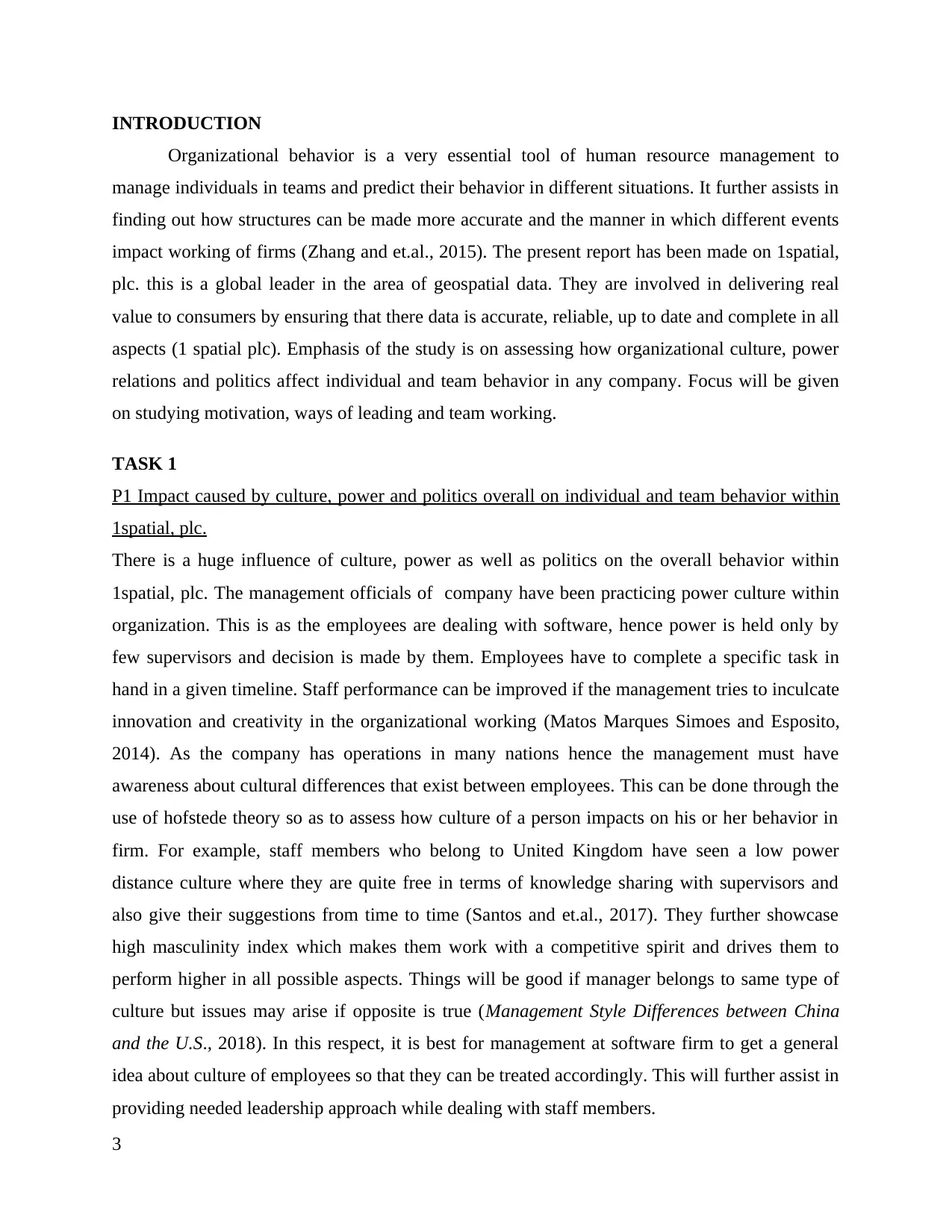
INTRODUCTION
Organizational behavior is a very essential tool of human resource management to
manage individuals in teams and predict their behavior in different situations. It further assists in
finding out how structures can be made more accurate and the manner in which different events
impact working of firms (Zhang and et.al., 2015). The present report has been made on 1spatial,
plc. this is a global leader in the area of geospatial data. They are involved in delivering real
value to consumers by ensuring that there data is accurate, reliable, up to date and complete in all
aspects (1 spatial plc). Emphasis of the study is on assessing how organizational culture, power
relations and politics affect individual and team behavior in any company. Focus will be given
on studying motivation, ways of leading and team working.
TASK 1
P1 Impact caused by culture, power and politics overall on individual and team behavior within
1spatial, plc.
There is a huge influence of culture, power as well as politics on the overall behavior within
1spatial, plc. The management officials of company have been practicing power culture within
organization. This is as the employees are dealing with software, hence power is held only by
few supervisors and decision is made by them. Employees have to complete a specific task in
hand in a given timeline. Staff performance can be improved if the management tries to inculcate
innovation and creativity in the organizational working (Matos Marques Simoes and Esposito,
2014). As the company has operations in many nations hence the management must have
awareness about cultural differences that exist between employees. This can be done through the
use of hofstede theory so as to assess how culture of a person impacts on his or her behavior in
firm. For example, staff members who belong to United Kingdom have seen a low power
distance culture where they are quite free in terms of knowledge sharing with supervisors and
also give their suggestions from time to time (Santos and et.al., 2017). They further showcase
high masculinity index which makes them work with a competitive spirit and drives them to
perform higher in all possible aspects. Things will be good if manager belongs to same type of
culture but issues may arise if opposite is true (Management Style Differences between China
and the U.S., 2018). In this respect, it is best for management at software firm to get a general
idea about culture of employees so that they can be treated accordingly. This will further assist in
providing needed leadership approach while dealing with staff members.
3
Organizational behavior is a very essential tool of human resource management to
manage individuals in teams and predict their behavior in different situations. It further assists in
finding out how structures can be made more accurate and the manner in which different events
impact working of firms (Zhang and et.al., 2015). The present report has been made on 1spatial,
plc. this is a global leader in the area of geospatial data. They are involved in delivering real
value to consumers by ensuring that there data is accurate, reliable, up to date and complete in all
aspects (1 spatial plc). Emphasis of the study is on assessing how organizational culture, power
relations and politics affect individual and team behavior in any company. Focus will be given
on studying motivation, ways of leading and team working.
TASK 1
P1 Impact caused by culture, power and politics overall on individual and team behavior within
1spatial, plc.
There is a huge influence of culture, power as well as politics on the overall behavior within
1spatial, plc. The management officials of company have been practicing power culture within
organization. This is as the employees are dealing with software, hence power is held only by
few supervisors and decision is made by them. Employees have to complete a specific task in
hand in a given timeline. Staff performance can be improved if the management tries to inculcate
innovation and creativity in the organizational working (Matos Marques Simoes and Esposito,
2014). As the company has operations in many nations hence the management must have
awareness about cultural differences that exist between employees. This can be done through the
use of hofstede theory so as to assess how culture of a person impacts on his or her behavior in
firm. For example, staff members who belong to United Kingdom have seen a low power
distance culture where they are quite free in terms of knowledge sharing with supervisors and
also give their suggestions from time to time (Santos and et.al., 2017). They further showcase
high masculinity index which makes them work with a competitive spirit and drives them to
perform higher in all possible aspects. Things will be good if manager belongs to same type of
culture but issues may arise if opposite is true (Management Style Differences between China
and the U.S., 2018). In this respect, it is best for management at software firm to get a general
idea about culture of employees so that they can be treated accordingly. This will further assist in
providing needed leadership approach while dealing with staff members.
3
⊘ This is a preview!⊘
Do you want full access?
Subscribe today to unlock all pages.

Trusted by 1+ million students worldwide
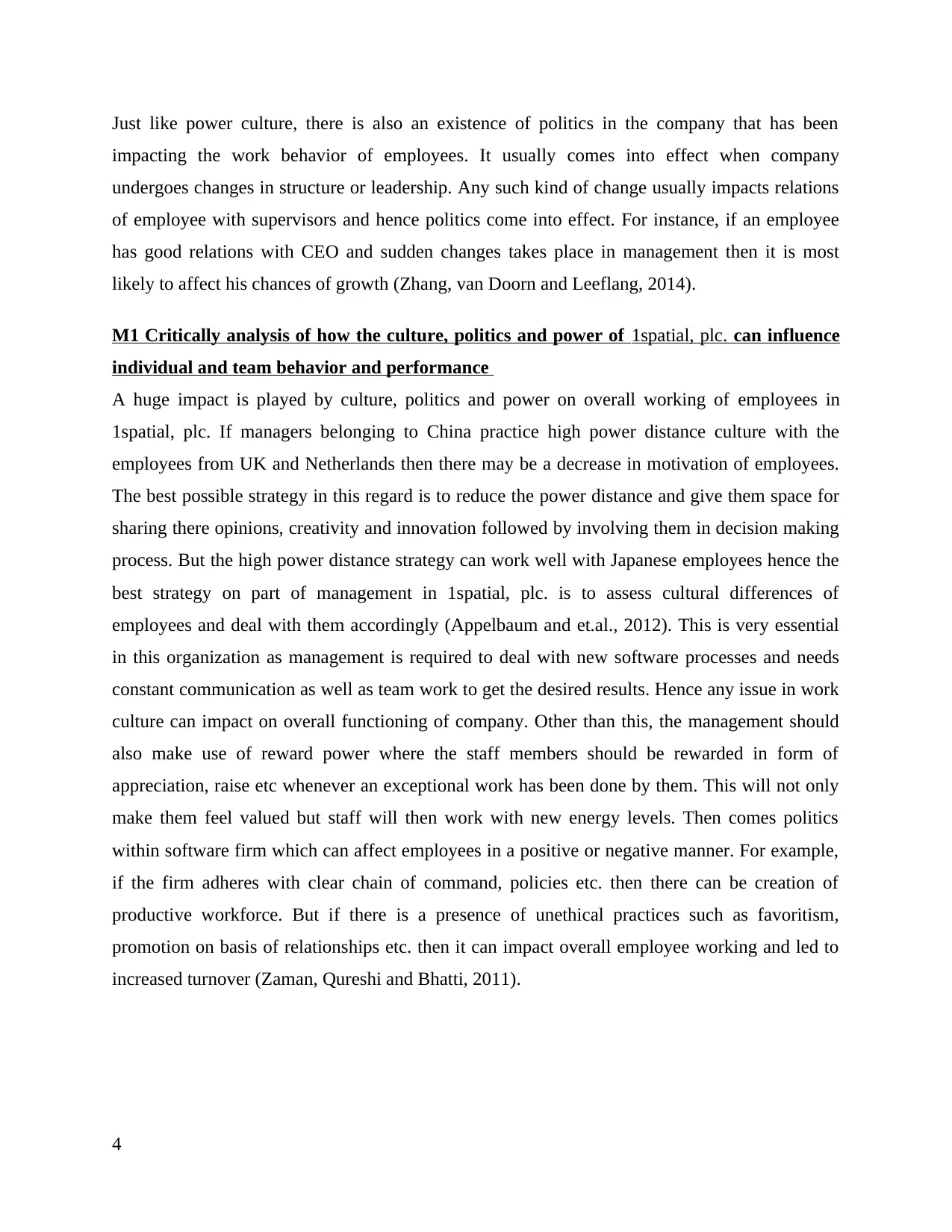
Just like power culture, there is also an existence of politics in the company that has been
impacting the work behavior of employees. It usually comes into effect when company
undergoes changes in structure or leadership. Any such kind of change usually impacts relations
of employee with supervisors and hence politics come into effect. For instance, if an employee
has good relations with CEO and sudden changes takes place in management then it is most
likely to affect his chances of growth (Zhang, van Doorn and Leeflang, 2014).
M1 Critically analysis of how the culture, politics and power of 1spatial, plc. can influence
individual and team behavior and performance
A huge impact is played by culture, politics and power on overall working of employees in
1spatial, plc. If managers belonging to China practice high power distance culture with the
employees from UK and Netherlands then there may be a decrease in motivation of employees.
The best possible strategy in this regard is to reduce the power distance and give them space for
sharing there opinions, creativity and innovation followed by involving them in decision making
process. But the high power distance strategy can work well with Japanese employees hence the
best strategy on part of management in 1spatial, plc. is to assess cultural differences of
employees and deal with them accordingly (Appelbaum and et.al., 2012). This is very essential
in this organization as management is required to deal with new software processes and needs
constant communication as well as team work to get the desired results. Hence any issue in work
culture can impact on overall functioning of company. Other than this, the management should
also make use of reward power where the staff members should be rewarded in form of
appreciation, raise etc whenever an exceptional work has been done by them. This will not only
make them feel valued but staff will then work with new energy levels. Then comes politics
within software firm which can affect employees in a positive or negative manner. For example,
if the firm adheres with clear chain of command, policies etc. then there can be creation of
productive workforce. But if there is a presence of unethical practices such as favoritism,
promotion on basis of relationships etc. then it can impact overall employee working and led to
increased turnover (Zaman, Qureshi and Bhatti, 2011).
4
impacting the work behavior of employees. It usually comes into effect when company
undergoes changes in structure or leadership. Any such kind of change usually impacts relations
of employee with supervisors and hence politics come into effect. For instance, if an employee
has good relations with CEO and sudden changes takes place in management then it is most
likely to affect his chances of growth (Zhang, van Doorn and Leeflang, 2014).
M1 Critically analysis of how the culture, politics and power of 1spatial, plc. can influence
individual and team behavior and performance
A huge impact is played by culture, politics and power on overall working of employees in
1spatial, plc. If managers belonging to China practice high power distance culture with the
employees from UK and Netherlands then there may be a decrease in motivation of employees.
The best possible strategy in this regard is to reduce the power distance and give them space for
sharing there opinions, creativity and innovation followed by involving them in decision making
process. But the high power distance strategy can work well with Japanese employees hence the
best strategy on part of management in 1spatial, plc. is to assess cultural differences of
employees and deal with them accordingly (Appelbaum and et.al., 2012). This is very essential
in this organization as management is required to deal with new software processes and needs
constant communication as well as team work to get the desired results. Hence any issue in work
culture can impact on overall functioning of company. Other than this, the management should
also make use of reward power where the staff members should be rewarded in form of
appreciation, raise etc whenever an exceptional work has been done by them. This will not only
make them feel valued but staff will then work with new energy levels. Then comes politics
within software firm which can affect employees in a positive or negative manner. For example,
if the firm adheres with clear chain of command, policies etc. then there can be creation of
productive workforce. But if there is a presence of unethical practices such as favoritism,
promotion on basis of relationships etc. then it can impact overall employee working and led to
increased turnover (Zaman, Qureshi and Bhatti, 2011).
4
Paraphrase This Document
Need a fresh take? Get an instant paraphrase of this document with our AI Paraphraser
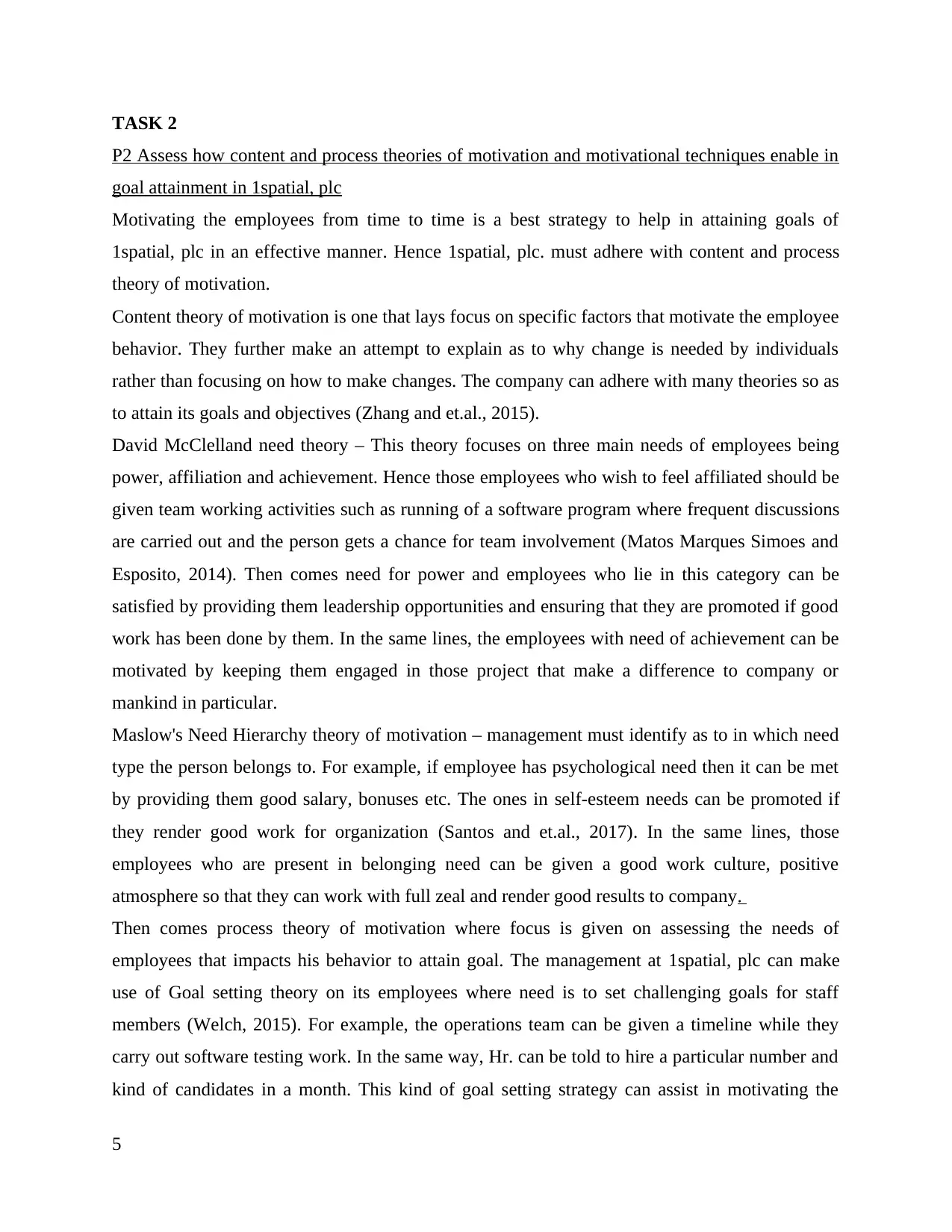
TASK 2
P2 Assess how content and process theories of motivation and motivational techniques enable in
goal attainment in 1spatial, plc
Motivating the employees from time to time is a best strategy to help in attaining goals of
1spatial, plc in an effective manner. Hence 1spatial, plc. must adhere with content and process
theory of motivation.
Content theory of motivation is one that lays focus on specific factors that motivate the employee
behavior. They further make an attempt to explain as to why change is needed by individuals
rather than focusing on how to make changes. The company can adhere with many theories so as
to attain its goals and objectives (Zhang and et.al., 2015).
David McClelland need theory – This theory focuses on three main needs of employees being
power, affiliation and achievement. Hence those employees who wish to feel affiliated should be
given team working activities such as running of a software program where frequent discussions
are carried out and the person gets a chance for team involvement (Matos Marques Simoes and
Esposito, 2014). Then comes need for power and employees who lie in this category can be
satisfied by providing them leadership opportunities and ensuring that they are promoted if good
work has been done by them. In the same lines, the employees with need of achievement can be
motivated by keeping them engaged in those project that make a difference to company or
mankind in particular.
Maslow's Need Hierarchy theory of motivation – management must identify as to in which need
type the person belongs to. For example, if employee has psychological need then it can be met
by providing them good salary, bonuses etc. The ones in self-esteem needs can be promoted if
they render good work for organization (Santos and et.al., 2017). In the same lines, those
employees who are present in belonging need can be given a good work culture, positive
atmosphere so that they can work with full zeal and render good results to company.
Then comes process theory of motivation where focus is given on assessing the needs of
employees that impacts his behavior to attain goal. The management at 1spatial, plc can make
use of Goal setting theory on its employees where need is to set challenging goals for staff
members (Welch, 2015). For example, the operations team can be given a timeline while they
carry out software testing work. In the same way, Hr. can be told to hire a particular number and
kind of candidates in a month. This kind of goal setting strategy can assist in motivating the
5
P2 Assess how content and process theories of motivation and motivational techniques enable in
goal attainment in 1spatial, plc
Motivating the employees from time to time is a best strategy to help in attaining goals of
1spatial, plc in an effective manner. Hence 1spatial, plc. must adhere with content and process
theory of motivation.
Content theory of motivation is one that lays focus on specific factors that motivate the employee
behavior. They further make an attempt to explain as to why change is needed by individuals
rather than focusing on how to make changes. The company can adhere with many theories so as
to attain its goals and objectives (Zhang and et.al., 2015).
David McClelland need theory – This theory focuses on three main needs of employees being
power, affiliation and achievement. Hence those employees who wish to feel affiliated should be
given team working activities such as running of a software program where frequent discussions
are carried out and the person gets a chance for team involvement (Matos Marques Simoes and
Esposito, 2014). Then comes need for power and employees who lie in this category can be
satisfied by providing them leadership opportunities and ensuring that they are promoted if good
work has been done by them. In the same lines, the employees with need of achievement can be
motivated by keeping them engaged in those project that make a difference to company or
mankind in particular.
Maslow's Need Hierarchy theory of motivation – management must identify as to in which need
type the person belongs to. For example, if employee has psychological need then it can be met
by providing them good salary, bonuses etc. The ones in self-esteem needs can be promoted if
they render good work for organization (Santos and et.al., 2017). In the same lines, those
employees who are present in belonging need can be given a good work culture, positive
atmosphere so that they can work with full zeal and render good results to company.
Then comes process theory of motivation where focus is given on assessing the needs of
employees that impacts his behavior to attain goal. The management at 1spatial, plc can make
use of Goal setting theory on its employees where need is to set challenging goals for staff
members (Welch, 2015). For example, the operations team can be given a timeline while they
carry out software testing work. In the same way, Hr. can be told to hire a particular number and
kind of candidates in a month. This kind of goal setting strategy can assist in motivating the
5
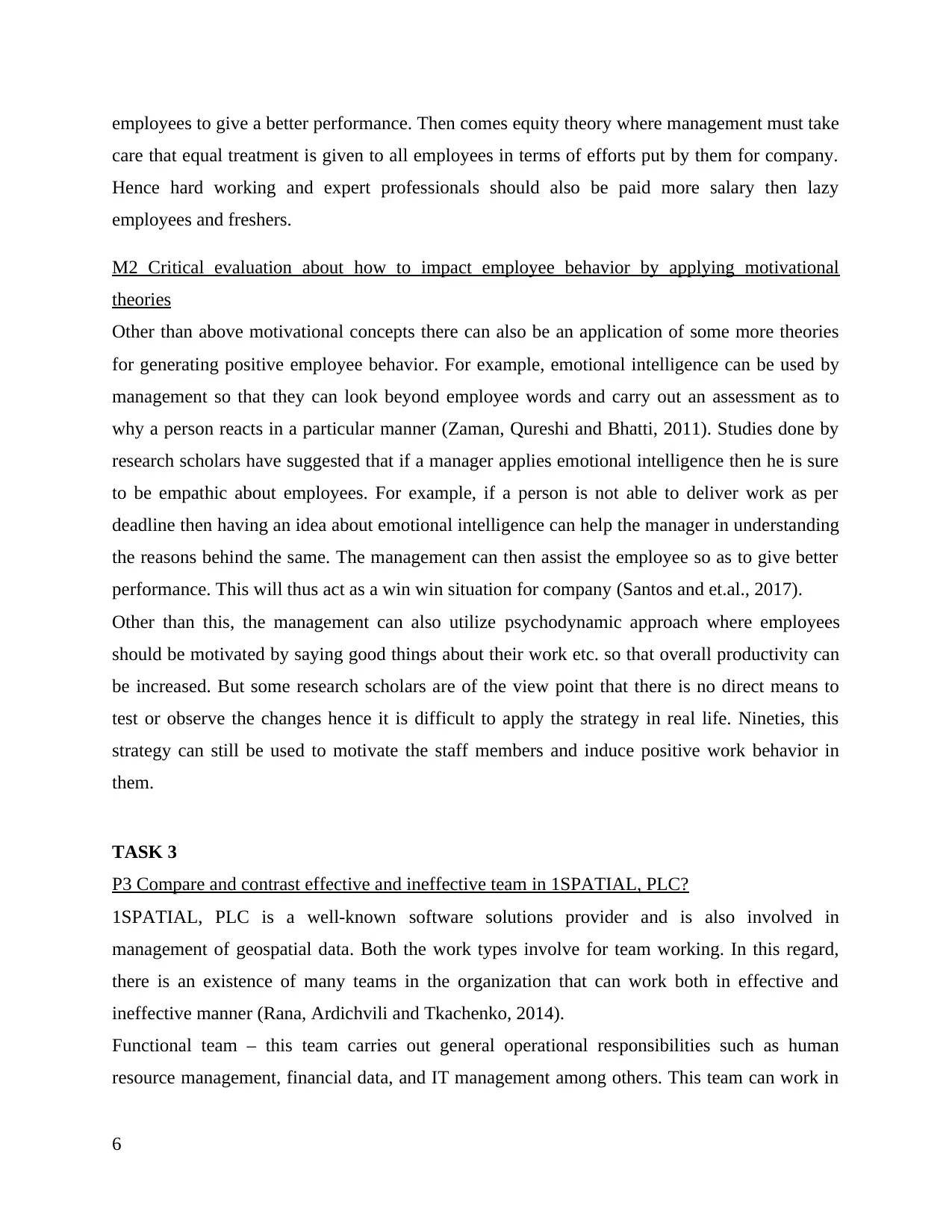
employees to give a better performance. Then comes equity theory where management must take
care that equal treatment is given to all employees in terms of efforts put by them for company.
Hence hard working and expert professionals should also be paid more salary then lazy
employees and freshers.
M2 Critical evaluation about how to impact employee behavior by applying motivational
theories
Other than above motivational concepts there can also be an application of some more theories
for generating positive employee behavior. For example, emotional intelligence can be used by
management so that they can look beyond employee words and carry out an assessment as to
why a person reacts in a particular manner (Zaman, Qureshi and Bhatti, 2011). Studies done by
research scholars have suggested that if a manager applies emotional intelligence then he is sure
to be empathic about employees. For example, if a person is not able to deliver work as per
deadline then having an idea about emotional intelligence can help the manager in understanding
the reasons behind the same. The management can then assist the employee so as to give better
performance. This will thus act as a win win situation for company (Santos and et.al., 2017).
Other than this, the management can also utilize psychodynamic approach where employees
should be motivated by saying good things about their work etc. so that overall productivity can
be increased. But some research scholars are of the view point that there is no direct means to
test or observe the changes hence it is difficult to apply the strategy in real life. Nineties, this
strategy can still be used to motivate the staff members and induce positive work behavior in
them.
TASK 3
P3 Compare and contrast effective and ineffective team in 1SPATIAL, PLC?
1SPATIAL, PLC is a well-known software solutions provider and is also involved in
management of geospatial data. Both the work types involve for team working. In this regard,
there is an existence of many teams in the organization that can work both in effective and
ineffective manner (Rana, Ardichvili and Tkachenko, 2014).
Functional team – this team carries out general operational responsibilities such as human
resource management, financial data, and IT management among others. This team can work in
6
care that equal treatment is given to all employees in terms of efforts put by them for company.
Hence hard working and expert professionals should also be paid more salary then lazy
employees and freshers.
M2 Critical evaluation about how to impact employee behavior by applying motivational
theories
Other than above motivational concepts there can also be an application of some more theories
for generating positive employee behavior. For example, emotional intelligence can be used by
management so that they can look beyond employee words and carry out an assessment as to
why a person reacts in a particular manner (Zaman, Qureshi and Bhatti, 2011). Studies done by
research scholars have suggested that if a manager applies emotional intelligence then he is sure
to be empathic about employees. For example, if a person is not able to deliver work as per
deadline then having an idea about emotional intelligence can help the manager in understanding
the reasons behind the same. The management can then assist the employee so as to give better
performance. This will thus act as a win win situation for company (Santos and et.al., 2017).
Other than this, the management can also utilize psychodynamic approach where employees
should be motivated by saying good things about their work etc. so that overall productivity can
be increased. But some research scholars are of the view point that there is no direct means to
test or observe the changes hence it is difficult to apply the strategy in real life. Nineties, this
strategy can still be used to motivate the staff members and induce positive work behavior in
them.
TASK 3
P3 Compare and contrast effective and ineffective team in 1SPATIAL, PLC?
1SPATIAL, PLC is a well-known software solutions provider and is also involved in
management of geospatial data. Both the work types involve for team working. In this regard,
there is an existence of many teams in the organization that can work both in effective and
ineffective manner (Rana, Ardichvili and Tkachenko, 2014).
Functional team – this team carries out general operational responsibilities such as human
resource management, financial data, and IT management among others. This team can work in
6
⊘ This is a preview!⊘
Do you want full access?
Subscribe today to unlock all pages.

Trusted by 1+ million students worldwide
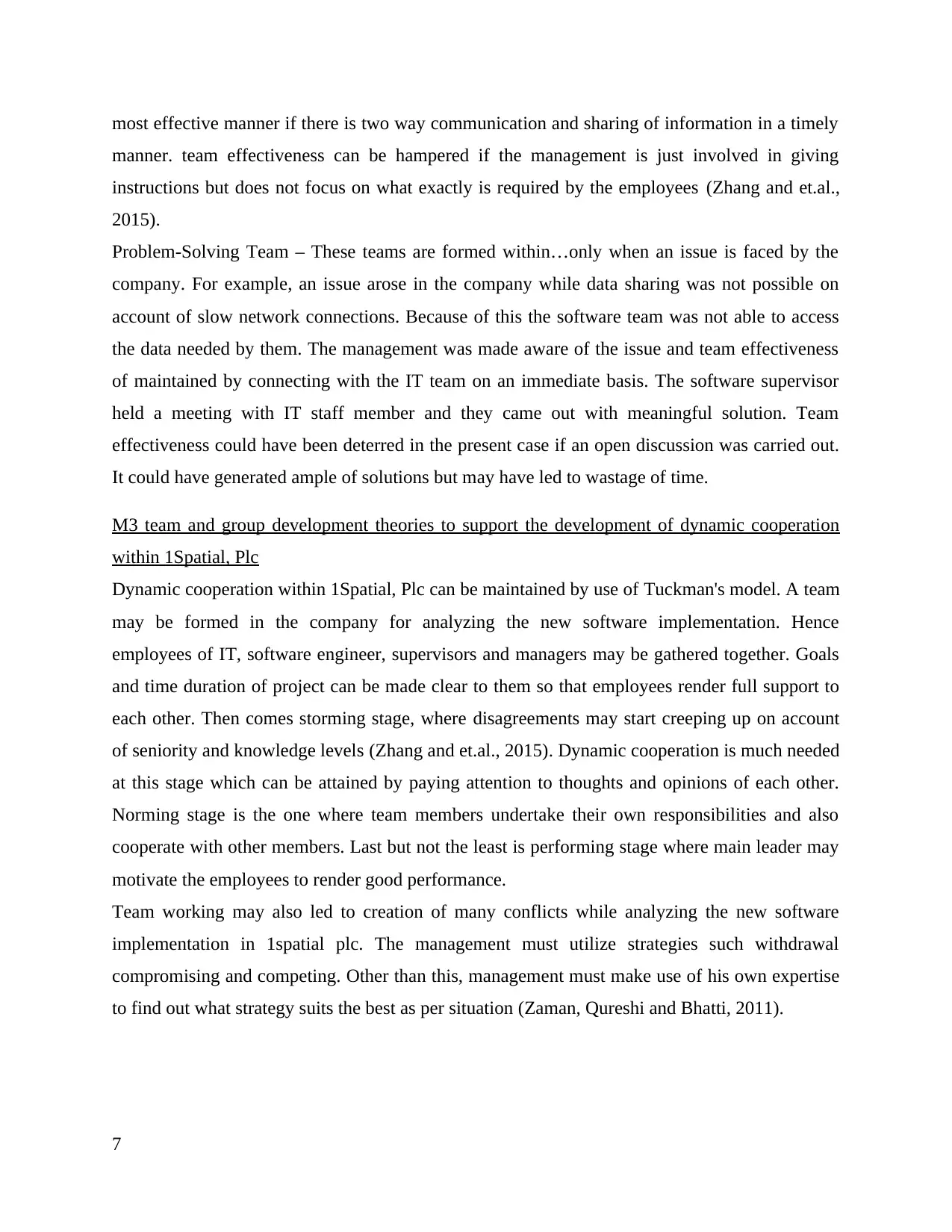
most effective manner if there is two way communication and sharing of information in a timely
manner. team effectiveness can be hampered if the management is just involved in giving
instructions but does not focus on what exactly is required by the employees (Zhang and et.al.,
2015).
Problem-Solving Team – These teams are formed within…only when an issue is faced by the
company. For example, an issue arose in the company while data sharing was not possible on
account of slow network connections. Because of this the software team was not able to access
the data needed by them. The management was made aware of the issue and team effectiveness
of maintained by connecting with the IT team on an immediate basis. The software supervisor
held a meeting with IT staff member and they came out with meaningful solution. Team
effectiveness could have been deterred in the present case if an open discussion was carried out.
It could have generated ample of solutions but may have led to wastage of time.
M3 team and group development theories to support the development of dynamic cooperation
within 1Spatial, Plc
Dynamic cooperation within 1Spatial, Plc can be maintained by use of Tuckman's model. A team
may be formed in the company for analyzing the new software implementation. Hence
employees of IT, software engineer, supervisors and managers may be gathered together. Goals
and time duration of project can be made clear to them so that employees render full support to
each other. Then comes storming stage, where disagreements may start creeping up on account
of seniority and knowledge levels (Zhang and et.al., 2015). Dynamic cooperation is much needed
at this stage which can be attained by paying attention to thoughts and opinions of each other.
Norming stage is the one where team members undertake their own responsibilities and also
cooperate with other members. Last but not the least is performing stage where main leader may
motivate the employees to render good performance.
Team working may also led to creation of many conflicts while analyzing the new software
implementation in 1spatial plc. The management must utilize strategies such withdrawal
compromising and competing. Other than this, management must make use of his own expertise
to find out what strategy suits the best as per situation (Zaman, Qureshi and Bhatti, 2011).
7
manner. team effectiveness can be hampered if the management is just involved in giving
instructions but does not focus on what exactly is required by the employees (Zhang and et.al.,
2015).
Problem-Solving Team – These teams are formed within…only when an issue is faced by the
company. For example, an issue arose in the company while data sharing was not possible on
account of slow network connections. Because of this the software team was not able to access
the data needed by them. The management was made aware of the issue and team effectiveness
of maintained by connecting with the IT team on an immediate basis. The software supervisor
held a meeting with IT staff member and they came out with meaningful solution. Team
effectiveness could have been deterred in the present case if an open discussion was carried out.
It could have generated ample of solutions but may have led to wastage of time.
M3 team and group development theories to support the development of dynamic cooperation
within 1Spatial, Plc
Dynamic cooperation within 1Spatial, Plc can be maintained by use of Tuckman's model. A team
may be formed in the company for analyzing the new software implementation. Hence
employees of IT, software engineer, supervisors and managers may be gathered together. Goals
and time duration of project can be made clear to them so that employees render full support to
each other. Then comes storming stage, where disagreements may start creeping up on account
of seniority and knowledge levels (Zhang and et.al., 2015). Dynamic cooperation is much needed
at this stage which can be attained by paying attention to thoughts and opinions of each other.
Norming stage is the one where team members undertake their own responsibilities and also
cooperate with other members. Last but not the least is performing stage where main leader may
motivate the employees to render good performance.
Team working may also led to creation of many conflicts while analyzing the new software
implementation in 1spatial plc. The management must utilize strategies such withdrawal
compromising and competing. Other than this, management must make use of his own expertise
to find out what strategy suits the best as per situation (Zaman, Qureshi and Bhatti, 2011).
7
Paraphrase This Document
Need a fresh take? Get an instant paraphrase of this document with our AI Paraphraser
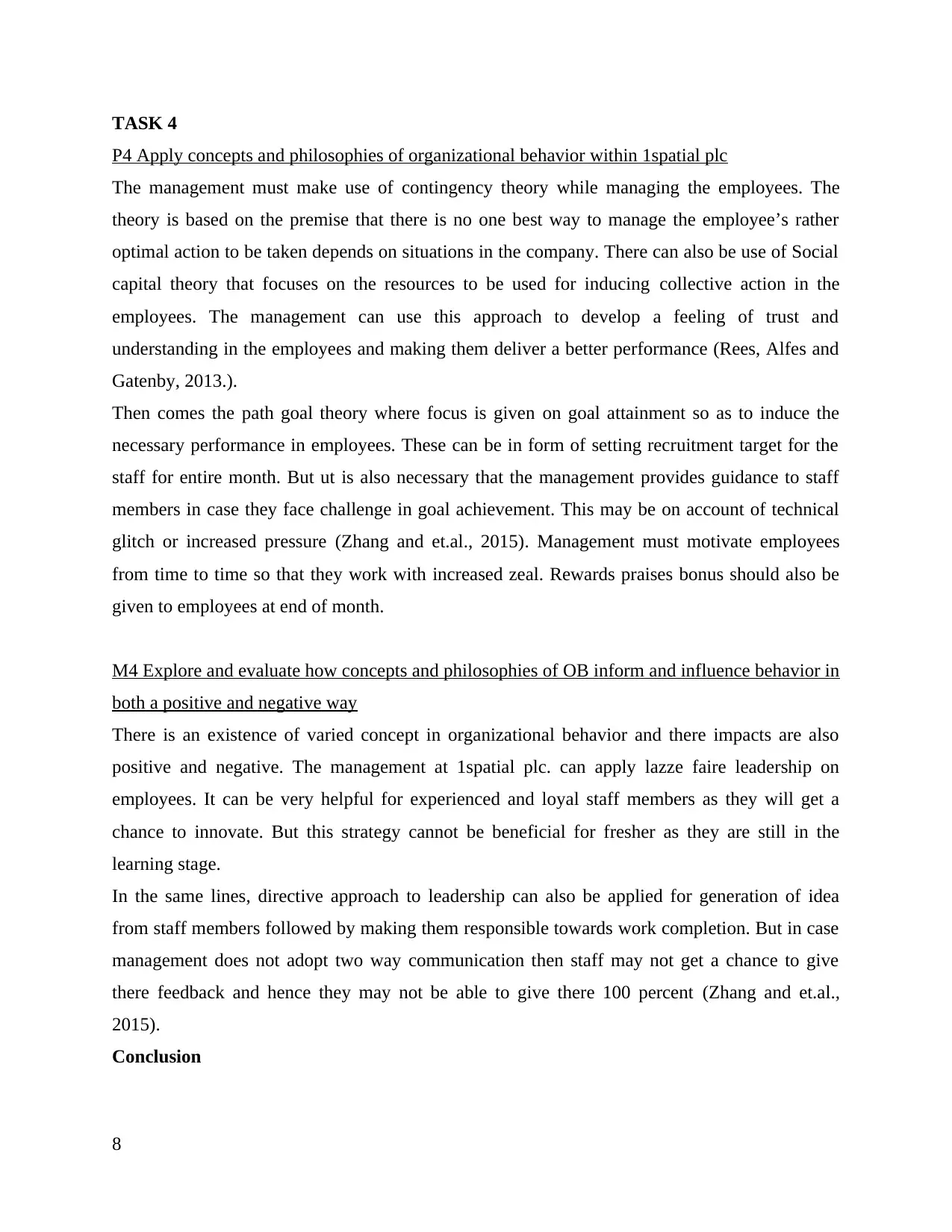
TASK 4
P4 Apply concepts and philosophies of organizational behavior within 1spatial plc
The management must make use of contingency theory while managing the employees. The
theory is based on the premise that there is no one best way to manage the employee’s rather
optimal action to be taken depends on situations in the company. There can also be use of Social
capital theory that focuses on the resources to be used for inducing collective action in the
employees. The management can use this approach to develop a feeling of trust and
understanding in the employees and making them deliver a better performance (Rees, Alfes and
Gatenby, 2013.).
Then comes the path goal theory where focus is given on goal attainment so as to induce the
necessary performance in employees. These can be in form of setting recruitment target for the
staff for entire month. But ut is also necessary that the management provides guidance to staff
members in case they face challenge in goal achievement. This may be on account of technical
glitch or increased pressure (Zhang and et.al., 2015). Management must motivate employees
from time to time so that they work with increased zeal. Rewards praises bonus should also be
given to employees at end of month.
M4 Explore and evaluate how concepts and philosophies of OB inform and influence behavior in
both a positive and negative way
There is an existence of varied concept in organizational behavior and there impacts are also
positive and negative. The management at 1spatial plc. can apply lazze faire leadership on
employees. It can be very helpful for experienced and loyal staff members as they will get a
chance to innovate. But this strategy cannot be beneficial for fresher as they are still in the
learning stage.
In the same lines, directive approach to leadership can also be applied for generation of idea
from staff members followed by making them responsible towards work completion. But in case
management does not adopt two way communication then staff may not get a chance to give
there feedback and hence they may not be able to give there 100 percent (Zhang and et.al.,
2015).
Conclusion
8
P4 Apply concepts and philosophies of organizational behavior within 1spatial plc
The management must make use of contingency theory while managing the employees. The
theory is based on the premise that there is no one best way to manage the employee’s rather
optimal action to be taken depends on situations in the company. There can also be use of Social
capital theory that focuses on the resources to be used for inducing collective action in the
employees. The management can use this approach to develop a feeling of trust and
understanding in the employees and making them deliver a better performance (Rees, Alfes and
Gatenby, 2013.).
Then comes the path goal theory where focus is given on goal attainment so as to induce the
necessary performance in employees. These can be in form of setting recruitment target for the
staff for entire month. But ut is also necessary that the management provides guidance to staff
members in case they face challenge in goal achievement. This may be on account of technical
glitch or increased pressure (Zhang and et.al., 2015). Management must motivate employees
from time to time so that they work with increased zeal. Rewards praises bonus should also be
given to employees at end of month.
M4 Explore and evaluate how concepts and philosophies of OB inform and influence behavior in
both a positive and negative way
There is an existence of varied concept in organizational behavior and there impacts are also
positive and negative. The management at 1spatial plc. can apply lazze faire leadership on
employees. It can be very helpful for experienced and loyal staff members as they will get a
chance to innovate. But this strategy cannot be beneficial for fresher as they are still in the
learning stage.
In the same lines, directive approach to leadership can also be applied for generation of idea
from staff members followed by making them responsible towards work completion. But in case
management does not adopt two way communication then staff may not get a chance to give
there feedback and hence they may not be able to give there 100 percent (Zhang and et.al.,
2015).
Conclusion
8
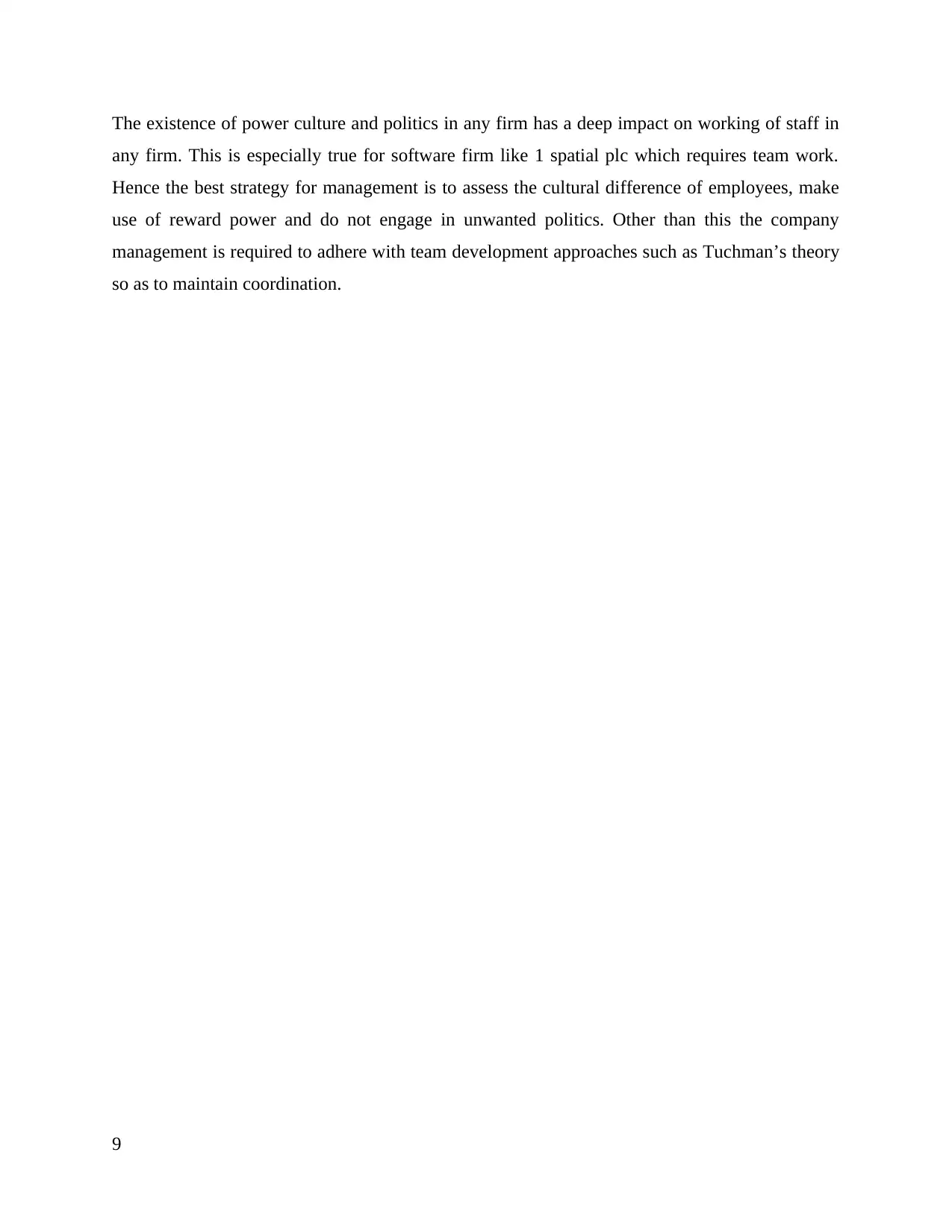
The existence of power culture and politics in any firm has a deep impact on working of staff in
any firm. This is especially true for software firm like 1 spatial plc which requires team work.
Hence the best strategy for management is to assess the cultural difference of employees, make
use of reward power and do not engage in unwanted politics. Other than this the company
management is required to adhere with team development approaches such as Tuchman’s theory
so as to maintain coordination.
9
any firm. This is especially true for software firm like 1 spatial plc which requires team work.
Hence the best strategy for management is to assess the cultural difference of employees, make
use of reward power and do not engage in unwanted politics. Other than this the company
management is required to adhere with team development approaches such as Tuchman’s theory
so as to maintain coordination.
9
⊘ This is a preview!⊘
Do you want full access?
Subscribe today to unlock all pages.

Trusted by 1+ million students worldwide
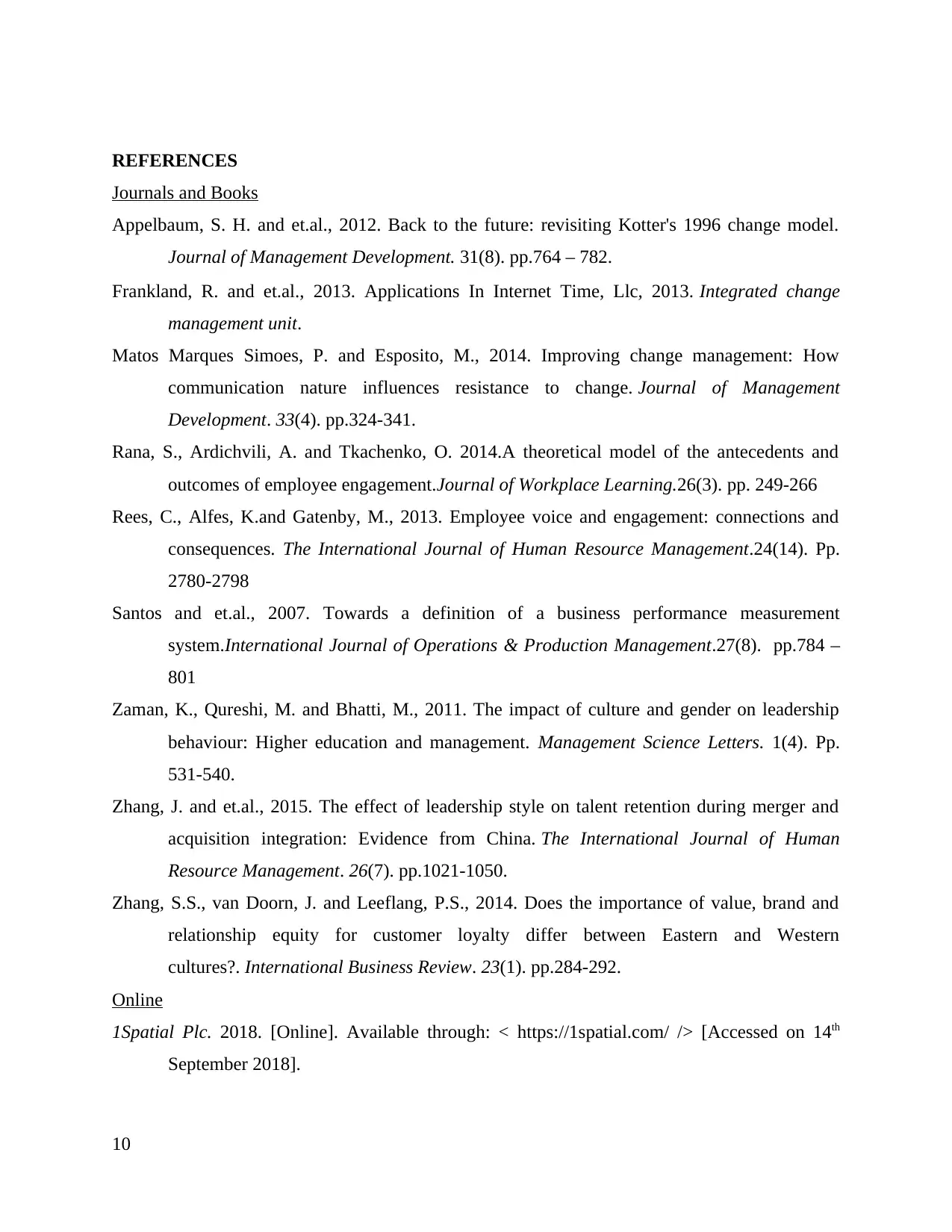
REFERENCES
Journals and Books
Appelbaum, S. H. and et.al., 2012. Back to the future: revisiting Kotter's 1996 change model.
Journal of Management Development. 31(8). pp.764 – 782.
Frankland, R. and et.al., 2013. Applications In Internet Time, Llc, 2013. Integrated change
management unit.
Matos Marques Simoes, P. and Esposito, M., 2014. Improving change management: How
communication nature influences resistance to change. Journal of Management
Development. 33(4). pp.324-341.
Rana, S., Ardichvili, A. and Tkachenko, O. 2014.A theoretical model of the antecedents and
outcomes of employee engagement.Journal of Workplace Learning.26(3). pp. 249-266
Rees, C., Alfes, K.and Gatenby, M., 2013. Employee voice and engagement: connections and
consequences. The International Journal of Human Resource Management.24(14). Pp.
2780-2798
Santos and et.al., 2007. Towards a definition of a business performance measurement
system.International Journal of Operations & Production Management.27(8). pp.784 –
801
Zaman, K., Qureshi, M. and Bhatti, M., 2011. The impact of culture and gender on leadership
behaviour: Higher education and management. Management Science Letters. 1(4). Pp.
531-540.
Zhang, J. and et.al., 2015. The effect of leadership style on talent retention during merger and
acquisition integration: Evidence from China. The International Journal of Human
Resource Management. 26(7). pp.1021-1050.
Zhang, S.S., van Doorn, J. and Leeflang, P.S., 2014. Does the importance of value, brand and
relationship equity for customer loyalty differ between Eastern and Western
cultures?. International Business Review. 23(1). pp.284-292.
Online
1Spatial Plc. 2018. [Online]. Available through: < https://1spatial.com/ /> [Accessed on 14th
September 2018].
10
Journals and Books
Appelbaum, S. H. and et.al., 2012. Back to the future: revisiting Kotter's 1996 change model.
Journal of Management Development. 31(8). pp.764 – 782.
Frankland, R. and et.al., 2013. Applications In Internet Time, Llc, 2013. Integrated change
management unit.
Matos Marques Simoes, P. and Esposito, M., 2014. Improving change management: How
communication nature influences resistance to change. Journal of Management
Development. 33(4). pp.324-341.
Rana, S., Ardichvili, A. and Tkachenko, O. 2014.A theoretical model of the antecedents and
outcomes of employee engagement.Journal of Workplace Learning.26(3). pp. 249-266
Rees, C., Alfes, K.and Gatenby, M., 2013. Employee voice and engagement: connections and
consequences. The International Journal of Human Resource Management.24(14). Pp.
2780-2798
Santos and et.al., 2007. Towards a definition of a business performance measurement
system.International Journal of Operations & Production Management.27(8). pp.784 –
801
Zaman, K., Qureshi, M. and Bhatti, M., 2011. The impact of culture and gender on leadership
behaviour: Higher education and management. Management Science Letters. 1(4). Pp.
531-540.
Zhang, J. and et.al., 2015. The effect of leadership style on talent retention during merger and
acquisition integration: Evidence from China. The International Journal of Human
Resource Management. 26(7). pp.1021-1050.
Zhang, S.S., van Doorn, J. and Leeflang, P.S., 2014. Does the importance of value, brand and
relationship equity for customer loyalty differ between Eastern and Western
cultures?. International Business Review. 23(1). pp.284-292.
Online
1Spatial Plc. 2018. [Online]. Available through: < https://1spatial.com/ /> [Accessed on 14th
September 2018].
10
Paraphrase This Document
Need a fresh take? Get an instant paraphrase of this document with our AI Paraphraser
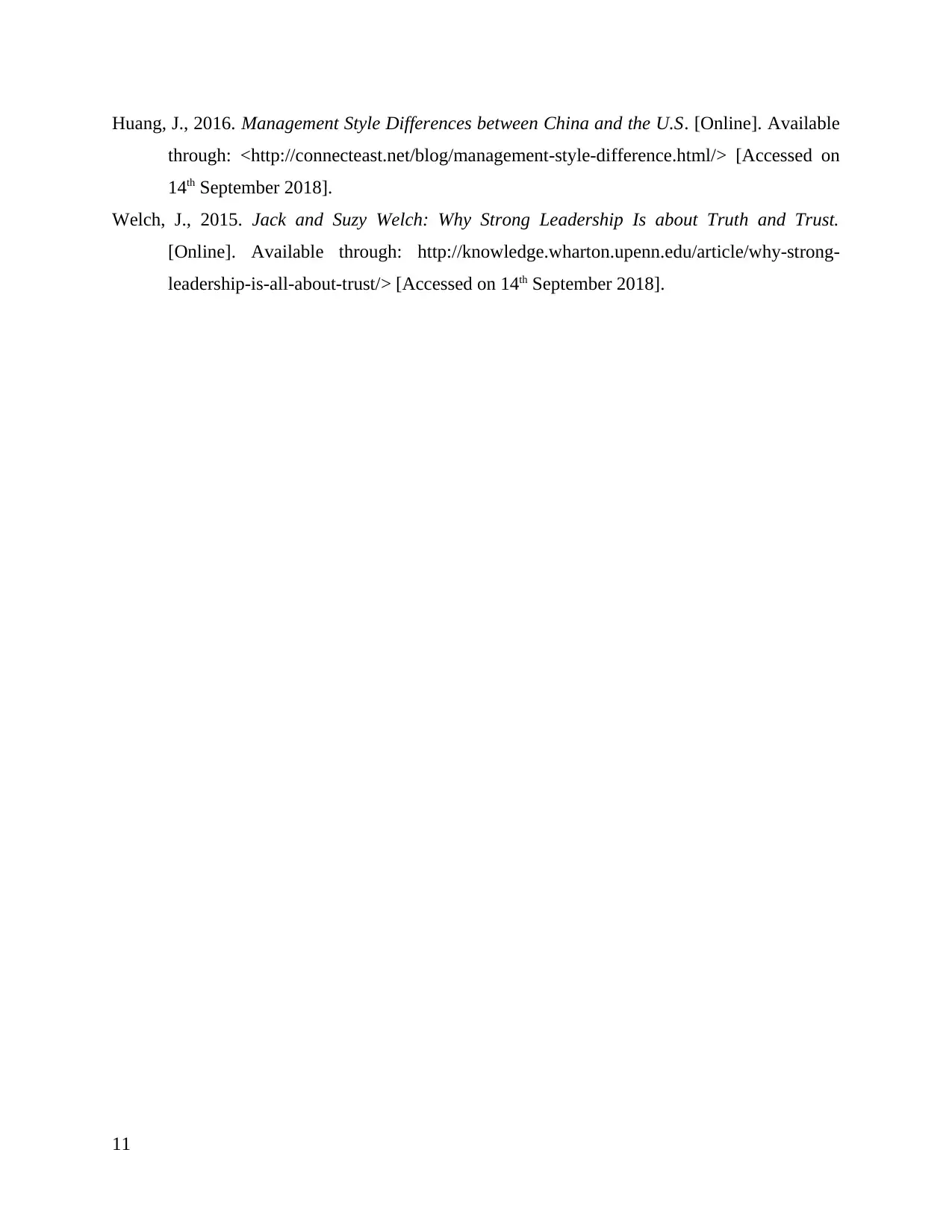
Huang, J., 2016. Management Style Differences between China and the U.S. [Online]. Available
through: <http://connecteast.net/blog/management-style-difference.html/> [Accessed on
14th September 2018].
Welch, J., 2015. Jack and Suzy Welch: Why Strong Leadership Is about Truth and Trust.
[Online]. Available through: http://knowledge.wharton.upenn.edu/article/why-strong-
leadership-is-all-about-trust/> [Accessed on 14th September 2018].
11
through: <http://connecteast.net/blog/management-style-difference.html/> [Accessed on
14th September 2018].
Welch, J., 2015. Jack and Suzy Welch: Why Strong Leadership Is about Truth and Trust.
[Online]. Available through: http://knowledge.wharton.upenn.edu/article/why-strong-
leadership-is-all-about-trust/> [Accessed on 14th September 2018].
11
1 out of 11
Related Documents
Your All-in-One AI-Powered Toolkit for Academic Success.
+13062052269
info@desklib.com
Available 24*7 on WhatsApp / Email
![[object Object]](/_next/static/media/star-bottom.7253800d.svg)
Unlock your academic potential
Copyright © 2020–2025 A2Z Services. All Rights Reserved. Developed and managed by ZUCOL.





